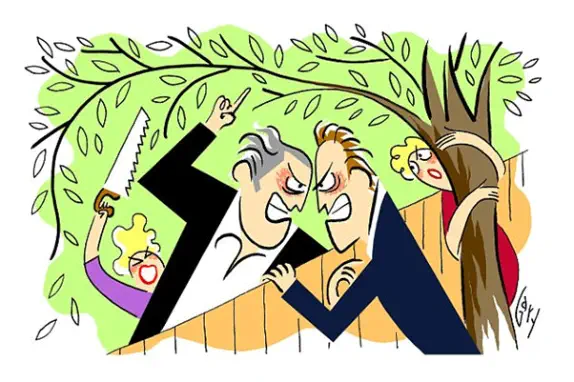

HOME | ABOUT | ARTICLES | NEWS | CONTACT US | TESTIMONIALS | DUE DILIGENCE
NEWS

BOUNDARY DISPUTES EVERYTHING YOU NEED TO KNOW
“If you remember the 1980s, we all liked to think
that neighbours became good friends. The reality
can be very different, with neighbour disputes
being some of the most common we deal with,
particularly over boundaries”.
Boundary disputes remain one of the most common sources of conflict between
neighbours. They can be stressful, time-consuming, and costly to resolve. In the
worst cases, the only viable option is to take legal action. However, boundary
disputes aren't unique to a residential setting; they can arise in various situations,
including commercial properties, agricultural land, and common land.
There are many factors which contribute to boundary disputes, including:
•
Unclear property deeds
•
Different interpretations of property boundaries
•
Fences, hedges or walls encroaching over a boundary
•
Boundary positions changing over time
•
Original boundaries being placed along an incorrect position
Confusion often arises because there are two concepts when looking at a boundary line. Firstly, a physical line separates the two plots (perhaps with a fence,
which can lead to fence disputes. Whilst parties can sometimes incur tens (or even hundreds) of thousands of pounds of legal costs arguing over the legal
boundary line, even after the parties have their day in Court, you can all but guarantee that the 'neighbourly' relations are never restored.
If you are faced with a boundary dispute, this guide will provide a helpful starting point and offer some practical guidance through the various aspects of
boundary disputes, resolving neighbour conflicts and your legal rights should you need to enforce them.
The Boundary Disputes Protocol ('BDP')
Is an excellent place to start. This is a non-binding, pre-action protocol. It provides "best practice" for resolving these types of disputes early. If the matter later
ends up in Court, a party's compliance will be viewed favourably when it comes to cost recovery.
What is a boundary dispute?
Usually, there is a dispute over the extent of land owned by one party or incorporated into a title, but they can relate to ownership of a boundary feature or
structure and the obligations of repair, replacement, or liability to contribute to the costs of the same.
Types of boundary disputes
There are many types of boundary disputes. The most common include when someone has built across the boundary line, and the injured party wants the
encroachment removed, or one party may wish to develop, but the boundary line is unclear and unmarked or another common dispute is when a party is
trespassing on land by using land that they thought to be theirs but isn't.
How to identify the legal boundary of your property
The title deeds do not always clearly define the legal boundary. However, the Land Registry is always a good starting point when establishing the boundary
between properties.
If this doesn't provide clarity, the next step is to gather any historic conveyances, transfers and plans relevant to the property to determine the 'root' conveyance.
If you need more than this, there is the option of taking the advice of a chartered surveyor to survey the land and report on the boundary or seeking legal advice to
help define and document the boundary line.
Common causes of boundary disputes
There are many causes of boundary disputes, including:
•
Development plans that encroach across legal boundary lines.
•
Aerial trespass, such as eaves and guttering of built extensions to the boundary line.
•
Poorly erected or replaced fencing in the wrong position.
•
Long rights of 'use' being misunderstood or abused.
How to resolve a boundary dispute
In order to preserve a good relationship with a neighbour, we would always suggest speaking to them in person where possible, or writing to them to explain the
issue which will give them a chance to respond.
If things have progressed passed this point, then seeking qualified legal advice and instructing an expert chartered surveyor is the first step in resolving a
boundary dispute. This will inevitably involve a site visit and the preparation of a detailed plan of the boundary.
The Royal Institute of Surveyors ('RICS') provides a helpful search function on its website from which specialist surveyors can be located.
Common myths and presumptions
When you're looking to resolve a boundary dispute, it is important not to rely on certain myths and presumptions which we commonly hear.
For example:
•
"You own the left-hand fence when facing your house."
•
"You own the right-hand fence when facing your house."
•
"A T-mark on a plan shows that you own the fence."
•
"The Land Registry title plan lets you scale up to confirm measurements."
These are but a few widely circulated myths with little to no accuracy. You should always refer to your own title documents and conveyance history, and where
appropriate, seek legal advice.
The Land Registry ('HMLR') title plans do not (save in the situation of a "determined boundary") establish the legal boundaries of the properties with any
precision. The plans used by the Land Registry are based on ordnance survey maps and are deemed to show only what are described as "general boundaries".
Therefore, reliance upon Land Registry title plans will, in most cases, be virtually worthless.
The T-Mark
There are also many misunderstandings around the T-Mark on documentation - this does not provide the clarity that is perceived by many about fence-
ownership.
A T-mark on a plan does not raise a presumption of ownership but may indicate ownership of a particular boundary feature.
The T-mark may identify the subject matter of an express repairing covenant and not indicate ownership of that feature itself. Instead, the T-marks are simply
one of several factors which can assist you in understanding the ownership of boundary features.
Correct presumptions
However, some presumptions do have merit in law. The "Hedge and Ditch" rule provides that where a hedge and a man-made ditch separate two properties, there
is a presumption that the boundary is along the opposite edge of the ditch from the hedge or bank.
Land abutting a highway is presumed to extend to the middle of the road (subject to the surface vesting in the Highways Authority, where appropriate), and the
same presumption applies to owners of property abutting a natural non-tidal river.
These presumptions are all rebuttable; in many cases, the presumptions will not provide anything like a definitive answer.
The law
When determining the position of a boundary, the Court's task is to ascertain the historic boundary line at the date of the earliest conveyance. That is when the
land was first divided and is known as the "root conveyance".
The Court must ultimately consider what a reasonable person, standing in the position of the parties with the relevant objective factual background knowledge,
would have understood the conveyance to mean about that particular boundary.
A party's subjective beliefs about the location of the boundary are not admissible as evidence.
The topographical features of the land at the time of the conveyance are often determinative of the position of the boundary, but of course, how easy it is to
understand the lay of the land at the appropriate time depends upon the date of the root conveyance.
Adverse possession
Once the position of the boundary is established, this could be the end of the matter. However, it frequently is not, as many factors may have come into play since
the root conveyance.
Unregistered land
Regarding unregistered land, a "squatter" may acquire title to their neighbour's land if they have "moved" the boundary line and have been in exclusive
possession of the land for 12 years.
Registered land
In respect of registered land, the Land Regsistration Act 2002(‘LRA 2002’) permits adverse possession of land if a neighbour has been in possession, for at least
ten years of land adjoining a general boundary and the squatter "reasonably believed" that they owned the land over that time.
The decision of the Court – relief
Assuming that a resolution cannot be reached, a judge will decide the legal boundary line and have wide discretion.
In some cases, the line may be found to be located at a position not advanced by either party but in which there is some gain and some loss.
Case law shows that judges are not obligated, in boundary disputes, to order the removal of any encroachments (injunctions) and could merely award damages
(financial compensation) in lieu. This can then amount to a pyrrhic victory for the "winning" party if a structure complained of remains in situ.
The costs of a boundary dispute
Of course, by the time parties reach Court, the trial is often more about costs than recovery of the land itself. Again, the Court retains a general discretion on costs
under rule 44.2 of the Civil Procedure Rules. It is by no means unheard of for a judge to disallow costs of a "successful" party in a neighbour dispute who has
exaggerated or inflated the importance of the claim (or even order the winning party to pay the other side's costs).
Indeed, the recent introduction of a fixed costs regime may impact the amounts recoverable inter parties, exposing any party to the costs they agree to pay on a
solicitor or own client basis.
As always, "without prejudice save as to costs" offers, compliance with pre-action protocols, and an early mediation offer is always advisable.
The Property Boundaries (Resolution of Disputes) Bill
Boundary disputes are fraught with difficulties, and in most cases, litigation costs dwarf the value of the land itself.
The RICS, in conjunction with the Property Litigation Association ('PLA'), have launched a joint Alternative Dispute Resolution ('ADR') service for boundary
disputes. As with most forms of ADR, the use of the process is voluntary, and there is currently no means to force parties to seek a resolution to their boundary
disputes outside of Court.
The Property Boundaries. (Resolution of Disputes Bill) has been going through Parliament since 2015. This Bill provides for the mandatory expert determination
of boundary disputes by a surveyor before the commencement of any court proceedings (much like the Party Wall etc. Act 1996) and was last revived in January
2020. Time will tell whether this long-running Bill will be revived and make its way onto the statute books, but it's probably unlikely.
Glossary of terms used in boundary disputes
Boundary agreements
These can be useful as a means of resolving disputes, but be wary of any limitation on the binding of successors in title (subsequent owners). Boundaries can be
‘Determined’ on application to HM Land Registry in some circumstances.
Boundary markers
Usually, physical features that indicate the intended position of a boundary, such as a tree line or hedge. Surveyors use new markers to ‘peg’ out what they
consider the legal boundary in the absence of other physical features.
Overhanging trees and shrubs
These can be cut back to remove any encroachment if it is reasonable to do so and does not cause disproportionate damage. Check for any preservation or
conservation orders and always return any ‘cuttings’ to the owner.
Encroachment
Is the offending trespass being suffered.
Adverse possession
Occupying land ‘adverse’ to the true owner’s rights for the required period of time (which varies depending on when this occurred and if the land is registered)
allows a ‘squatter’ to take possessory title to it.
Party walls
The most recognisable party wall is a wall that forms part of the building owner's building and stands on a boundary between the building owner's land and the
adjoining owner's land.
H&G



NEWS

BOUNDARY DISPUTES EVERYTHING YOU NEED TO
KNOW
“If you remember the 1980s, we all
liked to think that neighbours
became good friends. The reality can
be very different, with neighbour
disputes being some of the most
common we deal with, particularly
over boundaries”.
Boundary disputes remain one of the most common
sources of conflict between neighbours. They can be
stressful, time-consuming, and costly to resolve. In the
worst cases, the only viable option is to take legal action.
However, boundary disputes aren't unique to a residential
setting; they can arise in various situations, including
commercial properties, agricultural land, and common
land.
There are many factors which contribute to boundary
disputes, including:
•
Unclear property deeds
•
Different interpretations of property boundaries
•
Fences, hedges or walls encroaching over a boundary
•
Boundary positions changing over time
•
Original boundaries being placed along an incorrect
position
Confusion often arises because there are two concepts
when looking at a boundary line. Firstly, a physical line
separates the two plots (perhaps with a fence, which can
lead to fence disputes. Whilst parties can sometimes incur
tens (or even hundreds) of thousands of pounds of legal
costs arguing over the legal boundary line, even after the
parties have their day in Court, you can all but guarantee
that the 'neighbourly' relations are never restored.
If you are faced with a boundary dispute, this guide will
provide a helpful starting point and offer some practical
guidance through the various aspects of boundary disputes,
resolving neighbour conflicts and your legal rights should
you need to enforce them.
The Boundary Disputes Protocol
('BDP')
Is an excellent place to start. This is a non-binding, pre-
action protocol. It provides "best practice" for resolving
these types of disputes early. If the matter later ends up in
Court, a party's compliance will be viewed favourably when
it comes to cost recovery.
What is a boundary dispute?
Usually, there is a dispute over the extent of land owned by
one party or incorporated into a title, but they can relate to
ownership of a boundary feature or structure and the
obligations of repair, replacement, or liability to contribute
to the costs of the same.
Types of boundary disputes
There are many types of boundary disputes. The most
common include when someone has built across the
boundary line, and the injured party wants the
encroachment removed, or one party may wish to develop,
but the boundary line is unclear and unmarked or another
common dispute is when a party is trespassing on land by
using land that they thought to be theirs but isn't.
How to identify the legal boundary
of your property
The title deeds do not always clearly define the legal
boundary. However, the Land Registry is always a good
starting point when establishing the boundary between
properties.
If this doesn't provide clarity, the next step is to gather any
historic conveyances, transfers and plans relevant to the
property to determine the 'root' conveyance.
If you need more than this, there is the option of taking the
advice of a chartered surveyor to survey the land and report
on the boundary or seeking legal advice to help define and
document the boundary line.
Common causes of boundary disputes
There are many causes of boundary disputes, including:
•
Development plans that encroach across legal boundary
lines.
•
Aerial trespass, such as eaves and guttering of built
extensions to the boundary line.
•
Poorly erected or replaced fencing in the wrong position.
•
Long rights of 'use' being misunderstood or abused.
How to resolve a boundary dispute
In order to preserve a good relationship with a neighbour,
we would always suggest speaking to them in person where
possible, or writing to them to explain the issue which will
give them a chance to respond.
If things have progressed passed this point, then seeking
qualified legal advice and instructing an expert chartered
surveyor is the first step in resolving a boundary dispute.
This will inevitably involve a site visit and the preparation of
a detailed plan of the boundary.
The Royal Institute of Surveyors ('RICS') provides a helpful
search function on its website from which specialist
surveyors can be located.
Common myths and presumptions
When you're looking to resolve a boundary dispute, it is
important not to rely on certain myths and presumptions
which we commonly hear.
For example:
•
"You own the left-hand fence when facing your house."
•
"You own the right-hand fence when facing your house."
•
"A T-mark on a plan shows that you own the fence."
•
"The Land Registry title plan lets you scale up to confirm
measurements."
These are but a few widely circulated myths with little to no
accuracy. You should always refer to your own title
documents and conveyance history, and where appropriate,
seek legal advice.
The Land Registry ('HMLR') title plans do not (save in the
situation of a "determined boundary") establish the legal
boundaries of the properties with any precision. The plans
used by the Land Registry are based on ordnance survey
maps and are deemed to show only what are described as
"general boundaries". Therefore, reliance upon Land
Registry title plans will, in most cases, be virtually
worthless.
The T-Mark
There are also many misunderstandings around the T-Mark
on documentation - this does not provide the clarity that is
perceived by many about fence-ownership.
A T-mark on a plan does not raise a presumption of
ownership but may indicate ownership of a particular
boundary feature.
The T-mark may identify the subject matter of an express
repairing covenant and not indicate ownership of that
feature itself. Instead, the T-marks are simply one of several
factors which can assist you in understanding the
ownership of boundary features.
Correct presumptions
However, some presumptions do have merit in law. The
"Hedge and Ditch" rule provides that where a hedge and a
man-made ditch separate two properties, there is a
presumption that the boundary is along the opposite edge
of the ditch from the hedge or bank.
Land abutting a highway is presumed to extend to the
middle of the road (subject to the surface vesting in the
Highways Authority, where appropriate), and the same
presumption applies to owners of property abutting a
natural non-tidal river.
These presumptions are all rebuttable; in many cases, the
presumptions will not provide anything like a definitive
answer.
The law
When determining the position of a boundary, the Court's
task is to ascertain the historic boundary line at the date of
the earliest conveyance. That is when the land was first
divided and is known as the "root conveyance".
The Court must ultimately consider what a reasonable
person, standing in the position of the parties with the
relevant objective factual background knowledge, would
have understood the conveyance to mean about that
particular boundary.
A party's subjective beliefs about the location of the
boundary are not admissible as evidence.
The topographical features of the land at the time of the
conveyance are often determinative of the position of the
boundary, but of course, how easy it is to understand the lay
of the land at the appropriate time depends upon the date of
the root conveyance.
Adverse possession
Once the position of the boundary is established, this could
be the end of the matter. However, it frequently is not, as
many factors may have come into play since the root
conveyance.
Unregistered land
Regarding unregistered land, a "squatter" may acquire title
to their neighbour's land if they have "moved" the boundary
line and have been in exclusive possession of the land for 12
years.
Registered land
In respect of registered land, the Land Regsistration Act
2002(‘LRA 2002’) permits adverse possession of land if a
neighbour has been in possession, for at least ten years of
land adjoining a general boundary and the squatter
"reasonably believed" that they owned the land over that
time.
The decision of the Court – relief
Assuming that a resolution cannot be reached, a judge will
decide the legal boundary line and have wide discretion.
In some cases, the line may be found to be located at a
position not advanced by either party but in which there is
some gain and some loss.
Case law shows that judges are not obligated, in boundary
disputes, to order the removal of any encroachments
(injunctions) and could merely award damages (financial
compensation) in lieu. This can then amount to a pyrrhic
victory for the "winning" party if a structure complained of
remains in situ.
The costs of a boundary dispute
Of course, by the time parties reach Court, the trial is often
more about costs than recovery of the land itself. Again, the
Court retains a general discretion on costs under rule 44.2
of the Civil Procedure Rules. It is by no means unheard of for
a judge to disallow costs of a "successful" party in a
neighbour dispute who has exaggerated or inflated the
importance of the claim (or even order the winning party to
pay the other side's costs).
Indeed, the recent introduction of a fixed costs regime may
impact the amounts recoverable inter parties, exposing any
party to the costs they agree to pay on a solicitor or own
client basis.
As always, "without prejudice save as to costs" offers,
compliance with pre-action protocols, and an early
mediation offer is always advisable.
The Property Boundaries (Resolution
of Disputes) Bill
Boundary disputes are fraught with difficulties, and in most
cases, litigation costs dwarf the value of the land itself.
The RICS, in conjunction with the Property Litigation
Association ('PLA'), have launched a joint Alternative
Dispute Resolution ('ADR') service for boundary disputes. As
with most forms of ADR, the use of the process is voluntary,
and there is currently no means to force parties to seek a
resolution to their boundary disputes outside of Court.
The Property Boundaries. (Resolution of Disputes Bill) has
been going through Parliament since 2015. This Bill provides
for the mandatory expert determination of boundary
disputes by a surveyor before the commencement of any
court proceedings (much like the Party Wall etc. Act 1996)
and was last revived in January 2020. Time will tell whether
this long-running Bill will be revived and make its way onto
the statute books, but it's probably unlikely.
Glossary of terms used in boundary
disputes
Boundary agreements
These can be useful as a means of resolving disputes, but be
wary of any limitation on the binding of successors in title
(subsequent owners). Boundaries can be ‘Determined’ on
application to HM Land Registry in some circumstances.
Boundary markers
Usually, physical features that indicate the intended
position of a boundary, such as a tree line or hedge.
Surveyors use new markers to ‘peg’ out what they consider
the legal boundary in the absence of other physical features.
Overhanging trees and shrubs
These can be cut back to remove any encroachment if it is
reasonable to do so and does not cause disproportionate
damage. Check for any preservation or conservation orders
and always return any ‘cuttings’ to the owner.
Encroachment
Is the offending trespass being suffered.
Adverse possession
Occupying land ‘adverse’ to the true owner’s rights for the
required period of time (which varies depending on when
this occurred and if the land is registered) allows a ‘squatter’
to take possessory title to it.
Party walls
The most recognisable party wall is a wall that forms part of
the building owner's building and stands on a boundary
between the building owner's land and the adjoining
owner's land.
H&G

